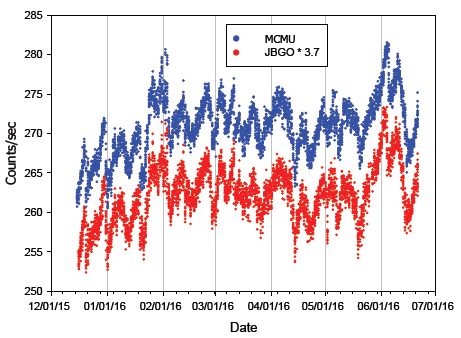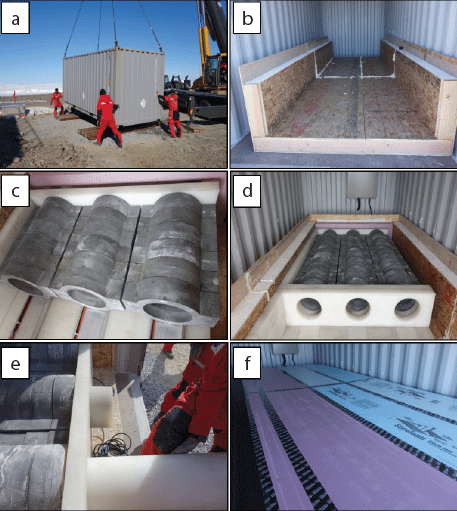1 INTRODUCTION
A neutron monitor is an instrument to detect neutrons on the ground base (Clem & Dorman 2000). Neutron monitors detect cosmic rays from the space indirectly. Incoming cosmic rays collide with molecules in the atmosphere to generate muons, neutrons, electrons, and photons (Grupen 2005). These particles are called secondary cosmic rays and neutron monitors detect neutrons among them.
Since the Earth is protected by the geomagnetic field, the direction of cosmic rays outside the mesosphere is quite different from that in the Earth’s atmosphere. Furthermore, the geomagnetic field hinders low energy particles from reaching the ground. Therefore, the amount of cosmic rays reaching the ground varies depending on the latitudes (Cooke et al. 1991).
One neutron monitor was installed at Korea Research Institute of Standards and Science (KRISS) in Daejeon and it has been in operation since 2011 (Kang et al. 2012), and using the data of that neutron monitor, Oh & Kang (2013) and Kang et al. (2016) have performed researches on cosmic rays.
In the recent, we have installed neutron monitor at Jang Bogo station in Antarctica. This is a part of mission to transfer the neutron monitor in the McMurdo station of USA to the Jang Bogo station, and this mission will be continued through 2017.
2 THE INSTALLATION OF NEUTRON MONITORS
The Jang Bogo science station is the second Korean station in the Antarctic which is located at the coast (74° 37.4´S, 164° 13.7´E) of Terra Nova Bay in Northern Victoria Land and the first Korean science station in mainland Antarctica.
The Jang Bogo station was completed in 2014 (Fig. 1). The latitude of the station is 10° higher than that of the King Sejong station and the climate is closer to that of Antarctica. Mean temperature at this location is -14 °C and the minimum temperature is -36 °C. It is named after the navy general, Jang Bogo, who set up Cheonghaejin and led the maritime trade among the Dang dynasty, the Shilla dynasty, and Japan.
There are Gondwana, German station and Mario Zucchelli, Italian station around the Jang Bogo station and these two stations are open only in summer season.
The Jang Bogo science station allows easy access from the center of Antarctica and from the coast. The location could serve as a research base for the studies on climate change, topographical and geological survey, the upper atmosphere, and space science to enable the acquisition of various data and characterized researches.
The McMurdo station which is one of the American stations is 360 km away from the Jang Bogo station and is located at southern part (77° 51´S, 166° 40´E) of Ross Island. The McMurdo station was established in 1955 and it is the largest station in Antarctica. For this station, the minimum temperature is -50 °C, and the maximum temperature is 8 °C and the mean annual temperature is -18 °C.
The Jang Bogo station and the McMurdo station are quite close to each other geographically and geo magnetically as shown in Table 1 and Fig. 2. Therefore, it is expected that the observation results at the McMurdo station could be reproduced at the Jang Bogo station.
| Station | Location | Altitude | Cutoff Rigidity | |
|---|---|---|---|---|
| Geographic | Geomagnetic | |||
| Jang Bogo | 74° 37.4´S | 77° 3´S | 29 m | < 0.2 GV |
| 164° 13.7´E | 85° 18´W | |||
| McMurdo | 77° 51´S | 78° 58.8´S | 48 m | < 0.2 GV |
| 166° 40´E | 72° 22.8´E | |||

At the Jang Bogo station, the neutron monitor was set up at the space weather observatory building which plays a quite significant role for researches on the upper atmosphere and the space environment in Antarctica. Currently, Vertical Incidence Pulse Radar, GPS/TEC scintillation monitor, neutron monitor, and Fabry-Perot interferometer are installed in this building and the all-sky cameras are supposed to be installed in this year.
The type of neutron monitor installed at the Jang Bogo station is a kind of NM64 neutron monitor. NM64 is also called super neutron monitor and it is designed by Hatton & Carmichael (1964). The NM64 neutron monitor mainly consists of three components, the reflector, the lead producer, and the moderator. The reflector moderates incoming neutron energy and reflects naturally occurring neutrons. The lead producer enhances moderation of neutrons and the moderator drives neutron particles with the state of almost < 1 eV to optimize the capture cross section of neutrons. Inside the moderator, there is a counter filled with 10BF3 gas and neutrons are detected in here. The reflector and the moderator are made of polyethylene.
Fig. 3 shows the sequential installation process of neutron monitors at the Jang Bogo station. Fig. 3(a) shows the unloading work of a container to the location of installation in which neutron monitor is to be installed; inside the container, there were packages of parts for 6 tubes of neutron monitor transported from the McMurdo station. Fig. 3(b) shows the installation of insulation material to cover neutron monitor after removing the packages. In order to fill the void space, foam processing was performed. Fig. 3(c) shows the installation process of the lead producer; the surface of the lead producer is covered with polyethylene which plays a role of the reflector, and a plate was installed under the lead producer for a heating purpose. Fig. 3(d) displays a lead producer for 3 tubes and their structure. Fig. 3(e) represents the tube installation process inside the lead producer and this tube contains the moderator and the BF3 counter. Fig. 3(f ) shows a completely sealed state after the installation was finished for a full insulation. The 18-NM64 neutron monitor at McMurdo station is supposed be relocated through 2017 and the relocation of six tubes was completed among them.
3 PRELIMINARY RESULTS
Currently, observation data obtained at the Jang Bogo neutron monitor are under comparison with those of the McMurdo neutron monitor. Fig. 4 represents the count rates of neutron monitors at the Jang Bogo station and the McMurdo neutron monitor. The data have been obtained during the period from 15th of December 2015 to 20th of June 2016. Blue dots indicate the neutron count data from the McMurdo neutron monitors while the Red dots indicate the neutron count data from the Jang Bogo neutron monitors. Currently, two units of 18-NM64 neutron monitor are in operation In the McMurdo station and one unit is in operation in the Jang Bogo station, thus, the figure shows a discrepancy in the total count rates of two neutron monitors. In the figure, the data from the Jang Bogo neutron monitors were multiplied by 3.7 to make the comparison easier. As you can see in the figure, the data of two neutron monitors agree well.

Fig. 5 shows the asymptotic direction of cosmic rays at five neutron monitors around the Antarctica. Blue dots represent the locations of neutron monitors and thick black lines indicate the asymptotic direction of neutron monitors for galactic cosmic ray particles. Since Jang Bogo station is located in the vicinity of McMrudo station and their cutoff rigidities are in the range of about 0.1 GV, their asymptotic directions are very similar.

4 SUMMARY
Neutron monitors on the ground detect neutrons as the secondary cosmic rays which are made by colliding with molecules in the atmosphere. They contribute significantly to the study of space environment.
We have installed neutron monitor at KRISS in Daejeon and researches have been performed using these monitors since 2011. Since last December, we have performed a mission to relocate the neutron monitor in the McMurdo station of USA to the Jang Bogo station of South Korea. 18- NM64 neutron monitor will be transferred in 2017 and six tubes as one unit were completed among 18 tubes.
Currently, comparison process is undergoing the data obtained at between the Jang Bogo and the McMurdo neutron monitors and it was found that those data agree well.
When the relocation mission is completed in 2017, the Jang Bogo neutron monitor is expected to make a great contribution to researches on space environment. Besides, we would have two neutron monitors which will be quite useful for the researches on cosmic rays in Korea.

